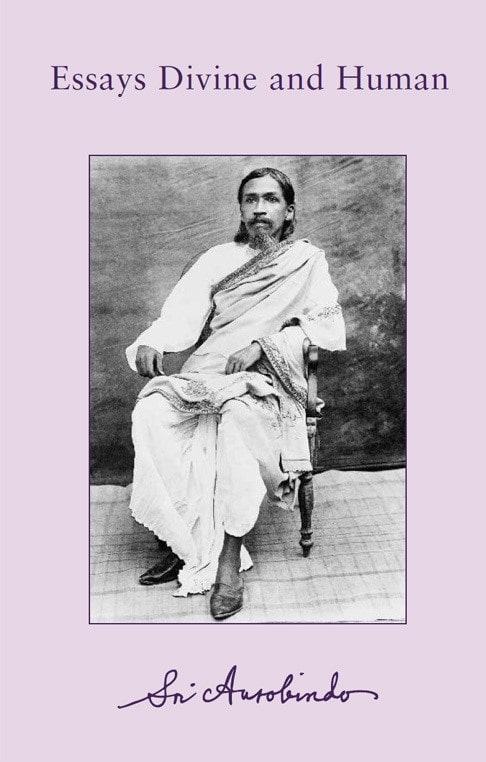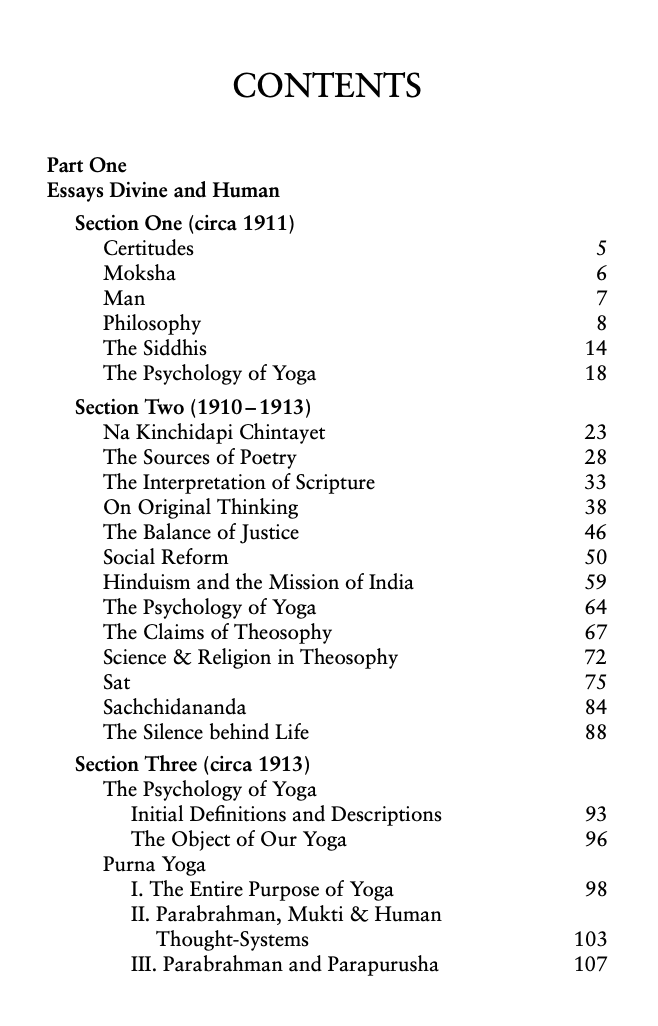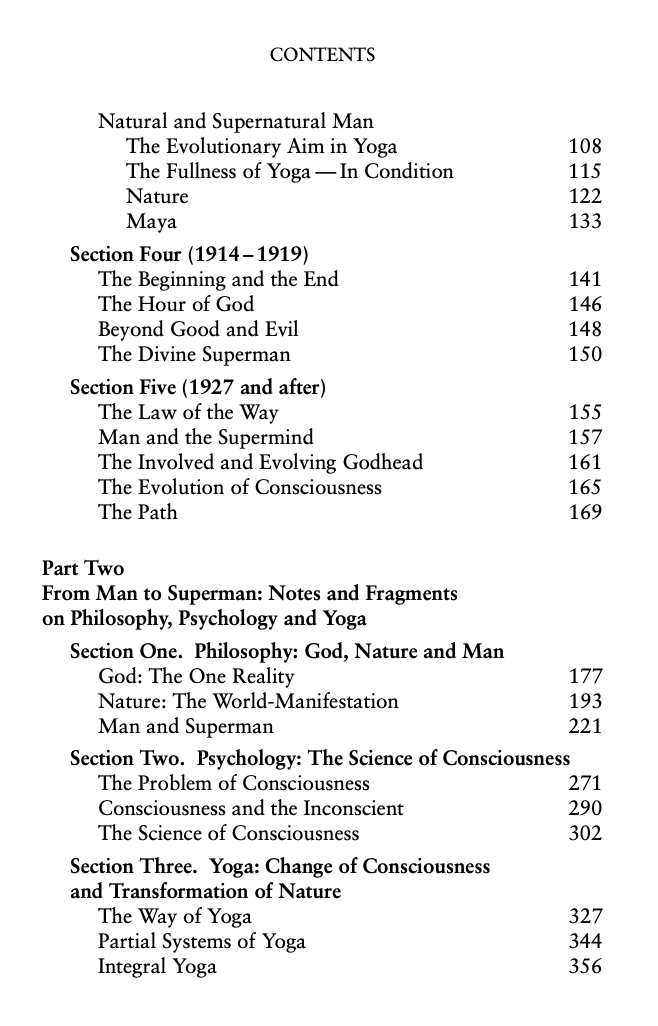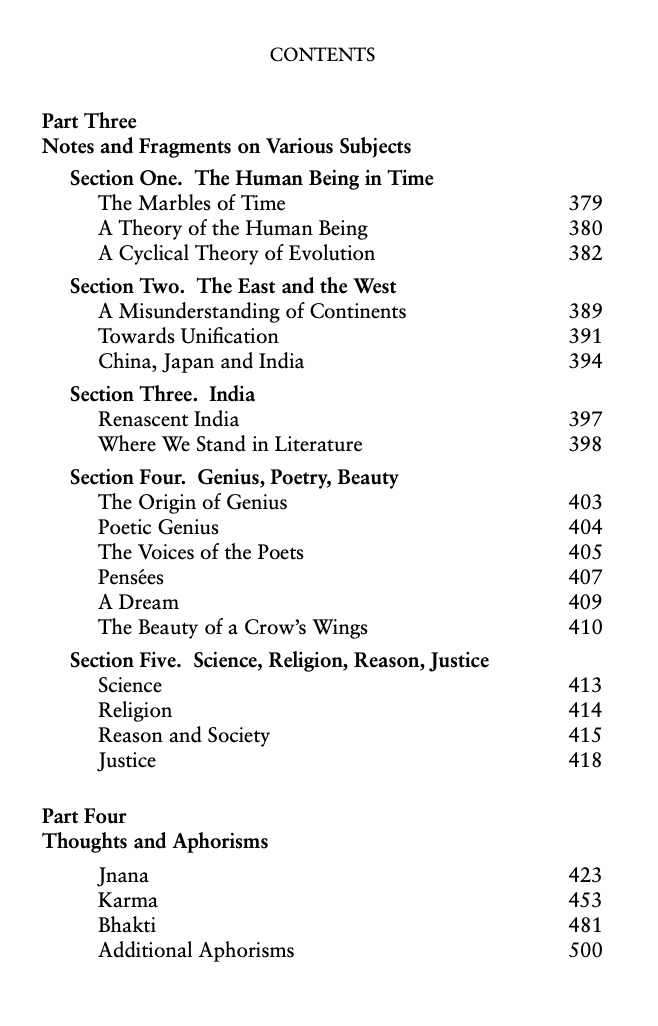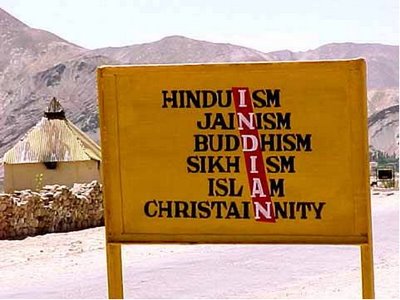Sometime last year I was invited to write a chapter for an upcoming book that attempted to survey all of Sri Aurobindo’s writings. I focused a lot on putting aside my trepidations and decided to just do the best I possibly could.
I’ve written a chapter that attempts to introduce Sri Aurobindo’s book Essays Divine and Human. This has now been published in the book titled Reading Sri Aurobindo, and is edited by Devdip Ganguli & Gautam Chikermane. I’ve reproduced my write-up below, and hope that it encourages you to pickup this inspiring volume.
An Introduction to Sri Aurobindo’s book – Essays Divine and Human
After arriving in Pondicherry in 1910, Sri Aurobindo continued writing, bringing his profound insights to a wide array of subjects. Essays Divine and Human includes essays, thoughts and aphorisms that will likely strike the reader as deeply uplifting and soul-stirring.
The old adage “still waters run deep” is perhaps best extended in the yogic suggestion of stillness, as expressed by Sri Aurobindo:
“When mind is still, then Truth gets her chance to be heard in the purity of the silence.” [1]Sri Aurobindo, The Complete Works of Sri Aurobindo, Volume 12, Sri Aurobindo Ashram Trust, (1997)., pp. 255.
In fact, the title of this volume has its origin in an essay titled The Silence behind Life [2]Ibid., pp. 88-89above which Sri Aurobindo wrote what became the title of this volume.
This book is primarily a collection of essays — on the Psychology of Yoga and the Science of Consciousness. Sri Aurobindo wrote extensively on God, nature, man and superman, and Yoga as a change of consciousness. One of the refrains in this book is that of man as a being of an intermediate nature:
“Man is a transitional being, he is not final. He is a middle term of the evolution, not its end, crown or consummating masterpiece.” [3]Ibid., pp. 221
Most of the material that appears in Part One of this volume was written before he began his seminal work for the Arya [4]This was a monthly philosophical review which Sri Aurobindo authored from 1914-1920. Most of what are now known as Sri Aurobindo’s major works were written during this period. The Life Divine, The Synthesis of Yoga and his myriad letters on yoga complement these earlier writings in this part of the book. One of the most memorable short essays in this book is On Original Thinking. Powerful and evocative, it serves as a timeless exhortation “to accept nothing, to question everything” and to “get rid of all unexamined opinions old or new.” [5]Ibid., pp. 41
Interestingly, one of Sri Aurobindo’s well-known quotes on man and reason appears in a draft version of this essay:
“Man may be, as he has been defined, a reasoning animal, but it is necessary to add that he is, for the most part, a very badly-reasoning animal. He does not ordinarily think for the sake of finding out the truth, but much more for the satisfaction of his mental preferences and emotional tendencies; his conclusions spring from his preferences, prejudices and passions; and his reasoning & logic paraded to justify them are only a specious process or a formal mask for his covert approach to an upshot previously necessitated by his heart or by his temperament.” [6]Ibid., pp. 41
This blazing essay is a wonderful supplement to Sri Aurobindo’s profound insights on education and should ideally be a part of the foundational documents for India’s National Education Policy. There are several shorter essays from Part One of the book which have received wide currency, such as ‘The Interpretation of Scripture,’ ‘Social Reform,’ and ‘Hinduism and the Mission of India.’
A large chunk of the book, ‘From Man to Superman’ overflows with the “Flamings of beauty into earthly shapes,” [7]Sri Aurobindo, The Complete Works of Sri Aurobindo, Volumes 33 and 34, Sri Aurobindo Ashram Trust (1997), pp. 77. that he writes of in his magnum opus, Savitri. This portion of the book has 171 short pieces written by Sri Aurobindo over a thirty-five-year period, from 1912 to 1947. While these were not prepared by him for publication, each of them offers invaluable insights for those who are looking for answers on questions of existence and yoga. Consider, for example, the Upanishadic seeking:
“Does universe ever end? Does it not exist eternally in God’s total idea of His own being? Unless the Eternal is tired out by Time as by a load, unless God suffers loss of memory, how can universe cease from being?” [8]Sri Aurobindo, The Complete Works of Sri Aurobindo, Volume 12, Sri Aurobindo Ashram Trust, (1997), pp. 144.
Or the revelatory image:
“The Suns are only physical concentrations of Light, but the splendour they concentrate for us is self-born and everywhere.” [9]Ibid., pp. 188.
The second part of this volume includes a treatise on one of the most pressing questions of modern society – what is Consciousness? Tomes have been written on this one word, and the frontiers of modern science still grope in the dark for a handle on this elusive concept – and secret to the riddle of existence. How are the nature and laws and movements of consciousness to be discovered within us? What we have within these fifty-odd pages is a progressive and systematic exploration of this subject, a grand tour of humanity’s quest for Self-Knowledge. Every view, every objection and denial is taken into account – the fumblings of physical science, the myopic lens of illusionism and the experiential advances of yogic seekers. Sri Aurobindo takes nothing for granted, and leads the reader logically towards what he refers to as a “True Scientific Psychology”.
But what makes Essays Divine and Human a unique book to me, the part that I find myself returning to time and again, is the section on Aphorisms. In India, the more well-known term for an aphorism is the Sanskrit word sutra. For several millennia, evolved individuals in India and in other parts of the world have employed this method to express profound ideas with great effect. Take for example, “the gods are mortals, men immortals.” [10]
Sri Aurobindo’s translation of the original Greek philosopher and mystic, Heraclitus. Sri Aurobindo, The Complete Works of Sri Aurobindo, Volume 13, Sri Aurobindo Ashram Trust (1998), pp. 217. These penetrating and pithy phrases cast a deep impression on all who come in touch with them, and many of these utterances have undoubtedly “lit the thoughts that glow through the centuries.” [11]Sri Aurobindo, The Complete Works of Sri Aurobindo, Volumes 33 and 34, Sri Aurobindo Ashram Trust (1997), pp. 259.
But what is it about the method of embedding Truth into such phrases that give them such durability? In one of the essays in this book, Sri Aurobindo reveals:
“The aphoristic method has great advantages. It prevents the mind from getting encrusted in details and fossilising there; it leaves a wide room & great latitude for originality & the delicate play of individuality in the details. It allows a science to remain elastic and full of ever new potentialities for the discoverer.” [12]Ibid., pp. 65.
Around the year 1913, Sri Aurobindo penned hundreds of scintillating aphorisms on a vast range of topics. He grouped these in his notebook under the three classical paths of Yoga – Jnana, Karma and Bhakti. In a way, these aphorisms constitute a synthesis of these paths of Yoga, expressed in a manner, as the Mother reveals, “always original and always unexpected.” [13]The Mother, The Collected Works of The Mother, Volume 10, Sri Aurobindo Ashram Trust (1977), pp. 333. In content, however, there is almost nothing classical about these flashes of revelation. Consider the utterance:
“God’s laughter is sometimes very coarse and unfit for polite ears” [14]Ibid., pp. 432.
Or:
“A God who cannot smile, could not have created this humorous universe” [15]Ibid., pp. 490.
These are radical departures from conventional images of God and his seriousness, and introduce ideas that inevitably challenge our prior beliefs and worldviews. Naturally, some of the earlier disciples had pressing questions on what Sri Aurobindo may have meant in these profound aphorisms and turned to the Mother for guidance. She was asked to help shed her light on almost each of these gems, and her commentaries have been diligently recorded in a book titled On Thoughts and Aphorisms. A single aphorism of Sri Aurobindo sometimes has an explanation ranging from a paragraph to several pages – and that alone makes this book an invaluable companion volume to Essays Divine and Human.
In one of her explanations, she provides an insight on the nature of Truth, the limitations of our reasoning minds (when we do use our reason) and why Sri Aurobindo chose this particular method of expression:
“Sri Aurobindo tells us that ‘the reason trembles’ because these higher truths always appear in the human domain as paradoxes, revelations contrary to reason; not because reason is incapable of understanding what comes from the higher regions, but because these revelations are always ahead of, very much ahead of, that which reason has understood or accepted. What the human reason of today finds reasonable has been paradoxical and mad in the past; and probably — one may say, certainly — these unexpected, paradoxical, revolutionary revelations which are manifesting now and making the reason tremble, will in time to come be very reasonable knowledge, which in turn will tremble before new revelations.
It is this sense of something which is always moving, progressing, being transformed, that Sri Aurobindo is trying to give us with these compact phrases which for a time shake our understanding of things. It is to push us forward, to give us the sense of the complete relativity of all that manifests in the world, and of this universe which is always in motion, ever moving towards a higher and greater Truth.” [16]Ibid., pp. 8-9.
Beyond the broad groupings of Jnana, Karma and Bhakti, Sri Aurobindo often classified the aphorisms by topic. So, for example, you would likely see the thoughts on history and historicity, or health and medicine grouped together. Each would illuminate a different aspect of the subject, in unique and surprising ways. The Mother, in one of her responses to a question on these aphorisms, said of Sri Aurobindo:
“…he presents each problem, each question in all its aspects, showing the truth contained in each way of seeing things, and he explains that in order to attain the Truth you must realise a synthesis which goes beyond all mental notions and emerge into a transcendence beyond thought.” [17]Ibid., pp. 96.
This many-sidedness of Truth is itself a theme in these aphorisms, and each of these could make you sit back and reflect. Every one of them offers us a chance to widen our outlook, and I can speak from my own experience – there is no going back once you have read them. As Sri Aurobindo wrote in one of his letters to a disciple:
“Anything that carries the Word, the Light in it, spoken or written, can light this fire within, open a sky, as it were, bring the effective vision of which the Word is the body.” [18]Sri Aurobindo, The Complete Works of Sri Aurobindo, Volume 29, Sri Aurobindo Ashram Trust, (2013), pp. 322-323.
Interestingly, if we look at the record of Sri Aurobindo’s commentaries on the sages of Greece, he has spent the majority of his time on a mystic, Heraclitus. Not Plato, not Socrates or any of the Stoics – but an earlier aphoristic philosopher, whose thought comes down to us
“in detached aphoristic sentences aimed like arrows at truth, still they are not really scattered philosophical reflections. There is an inter-relation, an inter-dependence; they all start logically from his fundamental view of existence itself and go back to it for their constant justification.” [19]Sri Aurobindo, The Complete Works of Sri Aurobindo, Volume 13, Sri Aurobindo Ashram Trust, (1998), pp. 221.
This interrelation and interdependence are evident in Sri Aurobindo’s aphorisms, – each of which is founded on his vast and all-encompassing experience of reality. In this volume, it is this beautiful tapestry, these profound and often uncommon groupings of ideas, images and symbols that give us contiguous glimpses of Sri Aurobindo’s divya-drishti (divine vision). Come and partake in the boundless joy and delight of these “Oceans of an immortal luminousness.” [20]Sri Aurobindo, The Complete Works of Sri Aurobindo, Volumes 33 and 34, Sri Aurobindo Ashram Trust, (1997), pp. 660.
References
| ↑1 | Sri Aurobindo, The Complete Works of Sri Aurobindo, Volume 12, Sri Aurobindo Ashram Trust, (1997)., pp. 255. |
|---|---|
| ↑2 | Ibid., pp. 88-89 |
| ↑3 | Ibid., pp. 221 |
| ↑4 | This was a monthly philosophical review which Sri Aurobindo authored from 1914-1920. Most of what are now known as Sri Aurobindo’s major works were written during this period |
| ↑5, ↑6 | Ibid., pp. 41 |
| ↑7 | Sri Aurobindo, The Complete Works of Sri Aurobindo, Volumes 33 and 34, Sri Aurobindo Ashram Trust (1997), pp. 77. |
| ↑8 | Sri Aurobindo, The Complete Works of Sri Aurobindo, Volume 12, Sri Aurobindo Ashram Trust, (1997), pp. 144. |
| ↑9 | Ibid., pp. 188. |
| ↑10 |
Sri Aurobindo’s translation of the original Greek philosopher and mystic, Heraclitus. Sri Aurobindo, The Complete Works of Sri Aurobindo, Volume 13, Sri Aurobindo Ashram Trust (1998), pp. 217. |
| ↑11 | Sri Aurobindo, The Complete Works of Sri Aurobindo, Volumes 33 and 34, Sri Aurobindo Ashram Trust (1997), pp. 259. |
| ↑12 | Ibid., pp. 65. |
| ↑13 | The Mother, The Collected Works of The Mother, Volume 10, Sri Aurobindo Ashram Trust (1977), pp. 333. |
| ↑14 | Ibid., pp. 432. |
| ↑15 | Ibid., pp. 490. |
| ↑16 | Ibid., pp. 8-9. |
| ↑17 | Ibid., pp. 96. |
| ↑18 | Sri Aurobindo, The Complete Works of Sri Aurobindo, Volume 29, Sri Aurobindo Ashram Trust, (2013), pp. 322-323. |
| ↑19 | Sri Aurobindo, The Complete Works of Sri Aurobindo, Volume 13, Sri Aurobindo Ashram Trust, (1998), pp. 221. |
| ↑20 | Sri Aurobindo, The Complete Works of Sri Aurobindo, Volumes 33 and 34, Sri Aurobindo Ashram Trust, (1997), pp. 660. |
